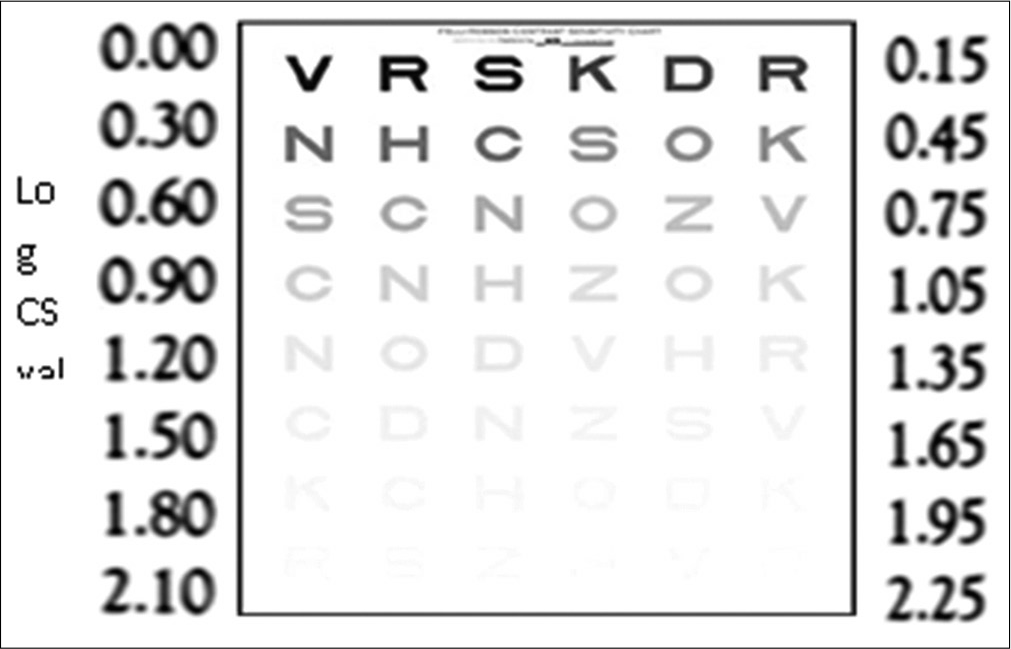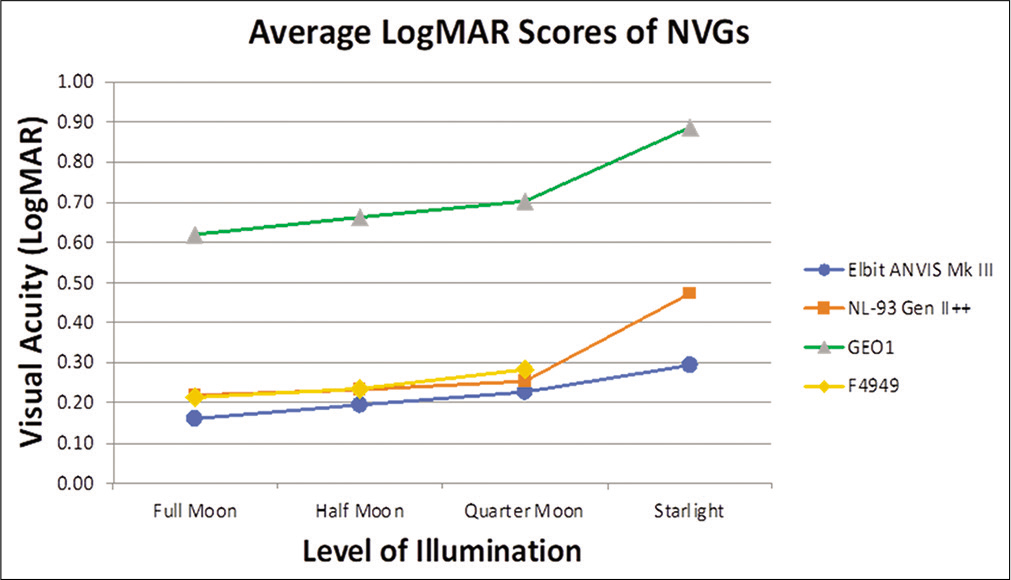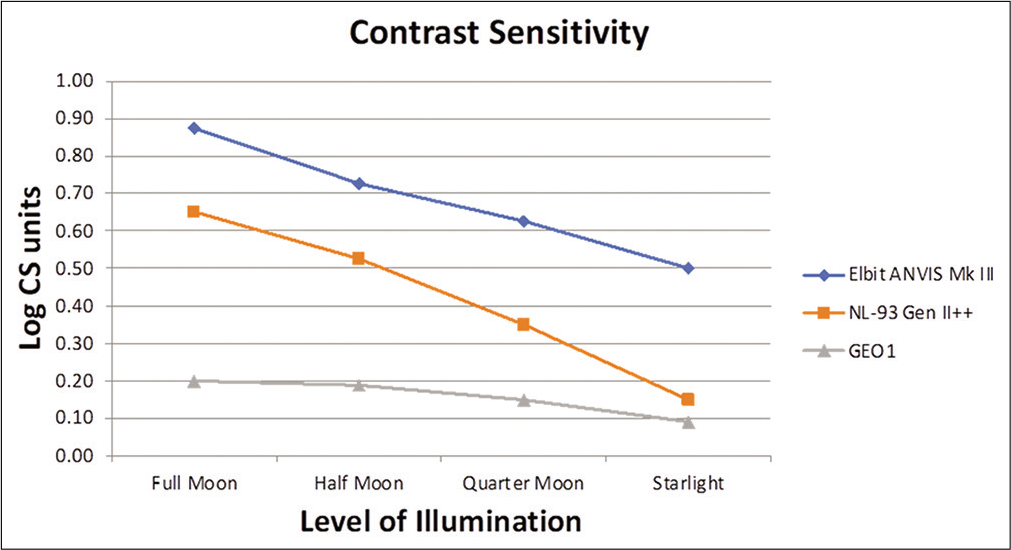Translate this page into:
Study of performance characteristics of ANVIS MK-III night-vision goggle and comparison with other NVGs for aviation usage

*Corresponding author: V. Raghunandan, Department of Human Engineering, Institute of Aerospace Medicine, Bengaluru, Karnataka, India. raghu.avmed@gmail.com
-
Received: ,
Accepted: ,
How to cite this article: Raghunandan V, Sekhar MB, Tripathy NK, Joshi VV. Study of performance characteristics of ANVIS MK-III night vision goggles and comparison with other night vision goggles in aviation usage. Indian J Aerosp Med 2022;66:21-6.
Abstract
Objectives:
Night Vision Goggles (NVGs) are widely used in military aviation. Performance of an NVG in terms of high resolution and target acquisition is considered a critical requirement. Gen III NVGs have been considered superior to Gen II and Gen II++ NVGs. The purpose of the study was to evaluate the performance characteristics of ANVIS MK-III NVG and compare them to those of other available NVGs.
Material and Methods:
ANVIS MK-III Gen III NVG was studied for its performance in terms of visual acuity (VA), contrast sensitivity, and field of view (FOV). Six subjects familiar with use of NVG participated in the study. VA was measured using USAF 1951 Tri-bar chart, while contrast sensitivity was measured using PelliRobson chart under full-moon (FM), half-moon (HF), quarter-moon (QM), and starlight (SL) conditions. The FOV was measured using Cross Bar chart. Comparisons were made with the data of other NVGs available with the Institute.
Results:
The mean VA of ANVIS MK-III NVG was found to be 20/29, 20/31, 20/34, and 20/39 under of FM, HF, QM, and SL illumination conditions, respectively. The mean contrast sensitivity was 0.9, 0.75, 0.6, and 0.53 log CS units, respectively, with mean FOV of 39.5°. The results were compared with performance characteristics of NL 93, GEO1, and F4949 NVGs.
Conclusion:
The ANVIS MK-III NVG was found to have higher VA function as compared to other NVGs and better contrast sensitivity function as compared to NL-93 and GEO1 NVG. All the NVGs had comparable FOV. The ANVIS Mk-III NVG in the current configuration with Helmet Display and Tracking System was found to be heavier and needs further ergonomic evaluation.
Keywords
Night-Vision Goggle
Visual acuity
Contrast sensitivity
Field of view
INTRODUCTION
The commitment toward enhancement of military night operations through development of night-vision devices has been exceptional. These image intensification systems have considerably improved the operational capabilities of air operations. With the advancement of image intensification technology,[1] the capabilities of night-vision goggles (NVGs) have steadily improved, and the NVGs have progressed from those requiring an infrared illuminator (Gen 0) to those capable of operating in starlight (SL) conditions today (Gen III).
Historically, NVGs used in Aviation requirements are of second-generation NVGs and above. Recently, there has been a significant transition to third-generation NVGs. Gen III NVGs have been claimed to have superior physical and performance characteristics compared to Gen II, Gen II+, and Gen II++ NVGs.[2,3] The performance characteristics of NVGs are defined by physical features,[4] their resolution limit or visual acuity (VA) performance,[5] contrast sensitivity,[6] and field of vision performance.
To quantify the improvement in the various performance characteristics, a study was undertaken using Gen III ANVIS Mk-III NVG. It was evaluated for its physical characteristics, VA, contrast sensitivity, and field of view (FOV) function and these parameters were compared with previously available performance reports of NL-93 Gen II++ NVG,[2,7] GEO1 NVG,[2,7] and F4949 NVG.[8]
MATERIAL AND METHODS
Study design
The study was a repeated measure experimental design, wherein performance characteristics of ANVIS Mk-III NVG were measured for same subjects under different illumination conditions and then were compared to those of other NVGs.
Subjects
A total of six healthy male volunteers who were familiar in NVG use participated in the study. The participants’ age ranged from 28 to 44 years, with a mean age of 34.5 + 5.37. Uncorrected Snellen’s VA of 6/6, no visual anomalies, no drinking or smoking for the previous 24 or 6 h, and sufficient sleep the night before were the inclusion requirements.
Materials
The test article was the ANVIS Mk-III NVG mounted on aircrew helmet. A weighing scale sensitive to third digit was used to measure the weight of the components. A modified gooseneck lamp equipped with a rheostat was utilized to simulate moon light conditions with variable illumination of full-moon (FM) (0.1 lux), half-moon (HF) (0.05 lux), quarter-moon (QM) (0.01 lux), and SL (0.0001 lux) conditions. At the level of the assessment charts, a Yokogawa Make Lux Meter was utilized to assess the required lighting.
The NVG Laboratory at IAM served as the site of experiment. The VA through NVG was recorded using USAF 1951 Tri-Bar Chart [Figure 1]. There are seven groups with six elements each in the tribar chart. Each element is made up of two-three bar designs, one of which is horizontally orientated and the other vertically. Each succeeding pattern is larger than the smaller element by a factor of the sixth root of two (or around 1.1225). This indicates that the size of the first element in each group is exactly twice that of the element in the following smaller group. The clearly distinguishable element (both vertical and horizontal) in the group through the NVG is recorded and converted into NVG resolution and VA using conversion factor. Pelli-Robson Chart was used to record contrast sensitivity. Eight rows of six capital letters in the upper case make up the Pelli-Robson chart. The letters are divided into three-letter groups. Snellen’s corresponding letters (20/60) are constant in size, but groups’ contrast is reduced by 0.15 log units. The examination was conducted similarly to a standard acuity test. As soon as, there were two or more mistakes in the group, the subject was asked to name the letters again. The last group in which at least two out of three letters is correctly identified determined the contrast threshold [Figure 2]. The Cross Bar Chart was used to measure the FOV with NVG [Figure 3]. The distance from which the outermost circle on the chart is visible through NVG is measured and the FOV through the NVG is calculated using trigonometry method.

- USAF 1951 tribar chart.

- Pelli-Robson contrast sensitivity chart.

- Field of view chart.
The previous reports on performance characteristics of NL-93 Gen II++ NVG, GEO1 NVG, and F4949 NVG were compiled to compare with that of the test NVG (M/s Elbit ANVIS Mk-III).
Experimental protocol
The study was undertaken at the NVG Laboratory of Institute of Aerospace Medicine, Bangalore. The participants were familiar on the adjusting and focusing procedures for the NVG. VA was measured for each participant through the ANVIS NVG Mk-III using USAF 1951 Tri-Bar Chart from a distance of 6 m at FM light condition (0.1 lux). The subject then moved to distance of 3 m from the Pelli-Robson chart and the contrast sensitivity was recorded under the same illumination condition. The measurement of VA and contrast sensitivity was repeated for HF (0.05 lux), QM (0.01 lux), and SL condition (0.0001 lux). The subjects were allowed to readjust only objective eye piece, if required during the experiment procedure. The test results were then compared with the previous reports on performance characteristics of NL-93 Gen II++ NVG, GEO1 NVG, and F4949 NVG available with this Institute. The data were analyzed using descriptive analysis of mean values and comparison between studies was done using graphical representation.
RESULTS
The NVG was mounted on TAN helmet integrated with Helmet Display and Tracking System (HDTS) [Figure 4]. The mounting plate for NVG was fixed on the helmet itself. The helmet including the mounting plate and HDTS without NVG weighed 2220 g. The ANVIS Mk-III NVG is a binocular device which has two objective lenses, two intensifying tubes, and two eye-pieces weighing 673.5 g. The battery pack located on the back of the helmet contained two battery cartridges having 02 AA batteries and weighed 181 g. The NVG mount weighed 85 g. A comparison of the component weight with other NVGs is presented in [Table 1].

- ANVIS Mk-III night-vision goggle with helmet display and tracking system.
| Component | ANVIS Mk-III | NL-93 | GEO1 | F4949 |
|---|---|---|---|---|
| Mount | 85 g | 180 g | 580 g | 195 g |
| NVG | 673.5 g | 530 g | 505 g | |
| Battery Pack | 181 g | 225 g | 520 g | 255 g |
| Counterweight | - | 270 g | - | |
| Total | 939.5 g | 1.205 Kg | 1.1 Kg | 995 g |
NVG: Night-vision goggle
The VA values in Snellen’s equivalent units for ANVIS Mk-III NVG are presented in [Table 2]. The mean VA of Gen III NVG was found to be 20/29, 20/31, 20/34, and 20/39 under of FM, HF, QM, and SL illumination conditions, respectively. Mean VA values (in Snellen’s equivalent units) of ANVIS NVG with other NVGs are tabulated in [Table 3]. A comparison of VA in LogMar units for ANVIS Mk-III NVG, NL-93 NVG, GEO1 NVG, and F4949 NVG is presented in [Figure 5].

- Visual acuity under different illumination conditions for ANVIS Mk-III night-vision goggle (NVG), NL-93 Gen II++ NVG, GEO1 NVG, and F4949 NVG.
| Full Moon (0.1 lux) | Half Moon (0.05 lux) | Quarter Moon (0.01 lux) | Starlight (0.0001 lux) | |||||
|---|---|---|---|---|---|---|---|---|
| Tribar Chart | Snellen’s equivalent | Tribar Chart | Snellen’s equivalent | Tribar Chart | Snellen’s equivalent | Tribar Chart | Snellen’s equivalent | |
| Subject 1 | −3.6 | 20/25.3 | −3.5 | 20/28.4 | −3.4 | 20/31.9 | −3.5 | 20/28.4 |
| Subject 2 | −3.5 | 20/28.4 | −3.4 | 20/31.9 | −3.3 | 20/35.8 | −3.2 | 20/40.2 |
| Subject 3 | −3.5 | 20/28.4 | −3.4 | 20/31.9 | −3.4 | 20/31.9 | −3.2 | 20/40.2 |
| Subject 4 | −3.5 | 20/28.4 | −3.5 | 20/28.4 | −3.4 | 20/31.9 | −3.1 | 20/45.1 |
| Subject 5 | −3.5 | 20/28.4 | −3.4 | 20/31.9 | −3.3 | 20/35.8 | −3.1 | 20/45.1 |
| Subject 6 | −3.3 | 20/35.8 | −3.3 | 20/35.8 | −3.3 | 20/35.8 | −3.2 | 20/40.2 |
| Mean VA | 20/28.9 | 20/31.3 | 20/33.8 | 20/39.4 | ||||
VA: Visual acuity
| NVGs | Full Moon (0.1 lux) | Half Moon (0.05 lux) | Quarter Moon (0.01 lux) | Starlight (0.0001 lux) |
|---|---|---|---|---|
| ANVIS Mk-III | 20/28.9 | 20/31.3 | 20/33.8 | 20/39.4 |
| NL-93 Gen II++ | 20/33.5 | 20/34.7 | 20/36.4 | 20/60.4 |
| GEO1 | 20/84.3 | 20/93.7 | 20/102.2 | 20/156.4 |
| F4949 | 20/32.7 | 20/34.3 | 20/38.5 | Report not available |
NVG: Night vision goggle, VA: Visual acuity
The contrast sensitivity values in CS log units for ANVIS Mk-III NVG are presented in [Table 4]. The mean contrast sensitivity was 0.9, 0.75, 0.6, and 0.53 log CS units under of FH, HF, QM, and SL illumination conditions, respectively. A comparison of contrast sensitivity in log CS units for ANVIS Mk-III NVG, NL-93 NVG, GEO1 NVG, and F4949 NVG is presented in [Table 5] and represented in [Figure 6].
FOV while using ANVIS Mk-III NVG was found to be 39.5° [Table 6]. A comparison of FOV for other NVGs is presented in [Table 7].
| Subject | Measured contrast sensitivity in various illumination conditions (CS Log units) | |||
|---|---|---|---|---|
| Full-moon (0.1 lux) | Half-moon (0.05 lux) | Quarter-moon (0.01 lux) | Starlight (0.0001 lux) | |
| Subject 1 | 0.9 | 0.75 | 0.6 | 0.6 |
| Subject 2 | 0.9 | 0.75 | 0.6 | 0.6 |
| Subject 3 | 0.9 | 0.9 | 0.75 | 0.6 |
| Subject 4 | 0.9 | 0.75 | 0.75 | 0.3 |
| Subject 5 | 0.9 | 0.6 | 0.45 | 0.45 |
| Subject 6 | 0.75 | 0.6 | 0.6 | 0.45 |
| Mean CS | 0.88 | 0.73 | 0.63 | 0.50 |
| NVGs | Full-Moon (0.1 lux) | Half-Moon (0.05 lux) | Quarter-Moon (0.01 lux) | Starlight (0.0001 lux) |
|---|---|---|---|---|
| ANVIS Mk-III | 0.88 | 0.73 | 0.63 | 0.5 |
| NL-93 Gen II++ | 0.65 | 0.53 | 0.35 | 0.15 |
| GEO1 | 0.20 | 0.19 | 0.15 | 0.09 |
NVG: Night-vision goggle
| Subject | FOV (in degrees) |
|---|---|
| Subject 1 | 37° |
| Subject 2 | 39.5° |
| Subject 3 | 42° |
| Subject 4 | 39.5° |
| Subject 5 | 39.5° |
| Mean FOV | 39.5° |
FOV: Field of view, NVG: Night-vision goggle
| ANVIS Mk-III NVG | 39.5° |
| NL-93 NVG | 40° |
| GEO1 | 38° |
| F4949 | 42° |
FOV: Field of view, NVG: Night-vision goggle

- Contrast sensitivity under different illumination conditions for ANVIS Mk-III night-vision goggle (NVG), NL-93 Gen II++ NVG, and GEO1 NVG (Report on CS study of F4949 NVG was not available).
DISCUSSION
The purpose of this study was to assess physical and performance characteristics of ANVIS Mk-III NVG and compare the same with other NVGs of interest, whose evaluation reports were available at this Institute. A total of six healthy participants with unaided 6/6 vision were assessed for their VA, contrast sensitivity, and FOV using ANVIS Mk-III NVG in the typical laboratory conditions of the NVG Laboratories eye lane room. The changes in VA and contrast sensitivity were studied under FM, HF, QM, and SL conditions.
Physical characteristics
Due to neck muscular tension and fatigue, the increased bulk of head-supported devices such as NVGs has a negative impact on pilot performance and increases the risk of serious neck injury during crashes.[9] Maintaining the weight and center of gravity of the NVG helmet and head combination within acceptable limits is critical to ensure pilot safety during routine and emergency. In this study, the weight of ANVIS Mk-III NVG (673.5 g) was found to be higher than the other NVGs of interest (530 g, 580 g, and 505 g). When NVG with mount and battery pack combination was compared, it was observed that the weight (939.5 g) was comparable to that of F4949 NVG (995 g) and lesser than the other NVGs [Table 1]. However, when integrated with the HDTS system (2.2 Kg), and the total mass of the ANVIS NVG-HDTS combination was found to be 3.07 kg, which is considered high. The same needs to be assessed for mass and force moment to ascertain the acceptability of increase in total mass of the NVG helmet combination. The same has not been carried out within the scope of the present study.
Visual acuity
VA has been commonly used to compare visual performance of NVG under different conditions of illumination and varying contrast.[3,6] In this study, VA performance for ANVIS Mk-III NVG showed decreasing trend with decreasing illumination [Table 2]. This is expected with any NVG and is due to increase in noise due to decreasing illumination.[1,3] However, when compared to other NVGs [Figure 5], VA was found to be consistently better even in low light illumination like the QM and SL conditions. This is an interesting finding and is definitely advantageous in target resolution under varying illumination conditions.
Contrast sensitivity
Assessment of contrast sensitivity through NVG is essential to evaluate pilot’s target detection and recognition capability over ranges of target size and contrast.[1] It has been suggested that the ability to distinguish adjacent areas of varying contrast ratios is only partially correlated with VA.[6] Since there is individual variation in the ability to discriminate low-contrast differences with NVGs,[6,10] contrast sensitivity has been suggested to be a valid predictor of NVG performance.
In this study, the contrast sensitivity was measured using Pelli-Robson chart and expressed in CS log units. It was observed that the contrast sensitivity of ANVIS Mk-III NVG decreased with decreasing illumination [Table 4], a finding similar to that observed in other NVGs.[6,7] When compared with NVGs of interest in this study, contrast sensitivity function was better than other NVGs. Similar to VA performance, the contrast sensitivity function was found to be consistently better than other NVGs even in low illumination conditions. This is again a relevant finding as CS function is critical for target recognition by pilot.
Field of view
The FOV measurement provides information on the angular size of the real-world picture that the NVG can analyze and display to the user at any given time. Typically, this is constant between similar-designed systems.[5] In this study, the mean FOV of ANVIS Mk-III NVG was 39.5° [Table 6] and as all the NVGs of interest in this study had binocular system, comparable results were observed [Table 7].
This study brought out methods of evaluation of an NVG which included examination of both physical and functional characteristics and these were compared to other NVGs of interest. ANVIS Mk-III NVG was found to be lighter and comparable to other binocular NVGs such as F4949 and GEO 1 NVG; however, in combination with the HDTS, on which the NVG is mounted, the overall weight was found to be higher which needs further ergonomic assessment. The ANVIS Mk-III NVG was found to surpass other NVGs in terms VA and contrast sensitivity function, with better, and consistent performance under low light illumination conditions which are a finding of operational significance.
The increase in weight of ANVIS Mk-III NVG-HTDS combination needs assessment of CoG to ascertain its effect on aircrew neck which has not been carried out in this study. The same is recommended to be carried out. The findings of the study are made in the absence of evaluation report of VA function of F4949 NVG under SL condition and contrast sensitivity of the same NVG. Better function of ANVIS MkIII NVG in comparison to F4949 NVG is inferred from VA performance under illumination conditions other than SL.
CONCLUSION
The study involved evaluation of physical and performance characteristics of ANVIS Mk-III NVG and its comparison with other NVGs, namely, NL-93 Gen II++, GEO1, and F4949 NVG, whose performance studies were available at this Institute. The ANVIS NVG was found to have higher VA function as compared to other NVGs and better contrast sensitivity function as compared to NL-93 and GEO1 NVG. All the NVGs had comparable FOV. The ANVIS Mk-III NVG in current configuration with HDTS was found to be heavier and needs further ergonomic evaluation.
Declaration of patient consent
The authors certify that they have obtained all appropriate patient consent.
Financial support and sponsorship
Nil.
Conflicts of interest
Dr. N. K. Tripathy is one of the IJASM Editorial Advisory Board Members. Dr. Vijay Vishnu Joshi is one of the ISAM Executive Committee Members.
References
- Night Vision Manual for the Flight Surgeon United States: Armstrong Lab Brooks AFB TX; 1992.
- [Google Scholar]
- A comparison of stereopsis with ANVIS and F4949 night vision Goggles. Aviat Space Environ Med. 1998;69:99-103.
- [Google Scholar]
- Visual acuity through night vision goggles (NVGs): A comparative assessment between gen 2++ and gen 3 NVGs under different illumination conditions. Indian J Aerosp Med. 2021;65:17-22.
- [CrossRef] [Google Scholar]
- The human factors of night vision Goggles: Perceptual, cognitive, and physical factors. Rev Hum Factors Ergon. 2011;7:238-79.
- [CrossRef] [Google Scholar]
- Measuring Observers' Visual Acuity through Night Vision Goggles. Air Force Research Lab Wright-Patterson AFB OH Human Effectiveness Directorate Report.
- [Google Scholar]
- Spatial contrast sensitivity through aviator's night vision imaging system. Aviat Space Environ Med. 1993;64:706-10.
- [Google Scholar]
- Variation in Contrast Sensitivity under Different Illumination Conditions While Using Gen 2++ and Gen 3 NVG In: Presented During 59th Indian Society of Aerospace Medicine Conference. 2020.
- [Google Scholar]
- Report on Aeromedical Evaluation of F4949 NVG. Department of Human Engineering, IAM.
- [Google Scholar]
- Performance history of AN/PVS-5 and ANVIS image intensification systems in US army aviation. Int Soc Optics Photonics. 1997;3058:264-98.
- [CrossRef] [Google Scholar]
- Predicting the Performance of Night Vision Devices using a Simple Contrast Model. Vol 1116. Bellingham: SPIE; 1989. p. :162-9.
- [CrossRef] [Google Scholar]






